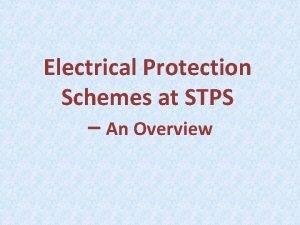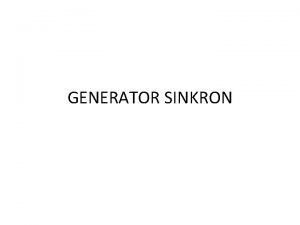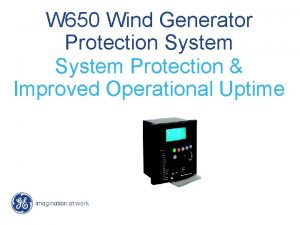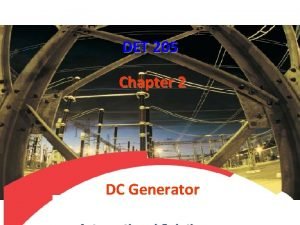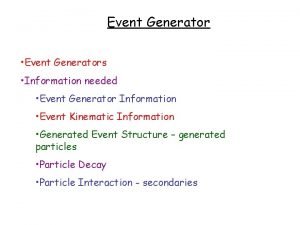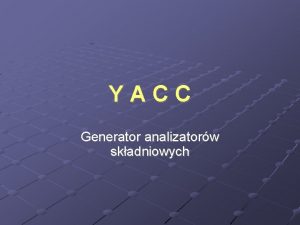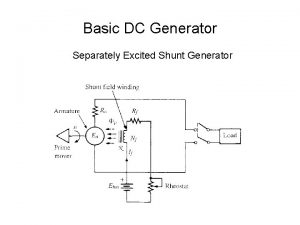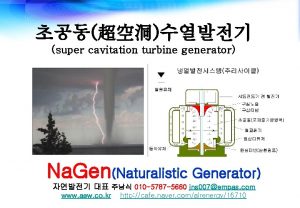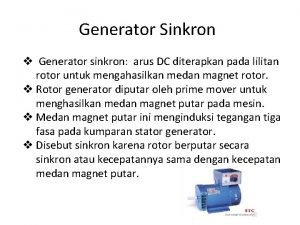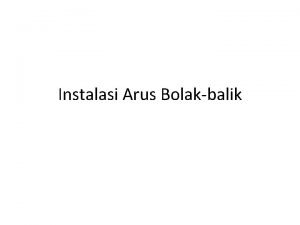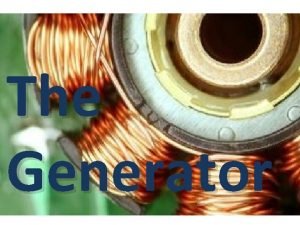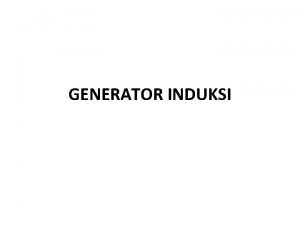Chapter 14 Generator protection Familiaring with the generator
















- Slides: 16

Chapter 14 Generator protection Familiaring with the generator fault, abnormal working condition, the principle of longitudinal differential protection of generator and setting principle; understanding of transverse differential protection for generator working principle; mastering the working principle of generator stator grounding protection 100% protection scope; understanding the excitation loop grounding point, two-point grounding protection; understanding the negative sequence overcurrent protection; mastering the generator loss of excitation protection; understanding gredients the characteristics of generator transformer protection. 14. 1 Generator faults , abnormal working conditions and their protection Generator is a very important and valuable equipment in the power system. The safe operation of the generator directly affects the safety of the power system.

Possible faults of generator and corresponding measures 1)Generator stator winding interphase short circuit The stator winding interphase short-circuit will cause great short circuit current, which will seriously damage the generator and even cause fire. Longitudinal differential protection shall be installed. 2)Generator stator winding turn to turn short circuit The stator winding turn to turn short circuit will produce the big circulation, cause the temperature rise at the fault, make the insulation aging, even breakdown the insulation development for the single-phase ground or the interphase short circuit, expands the generator damage scope.

3)Single phase earthing of generator stator winding Single phase grounding of stator winding is a kind of fault that generator is prone to occur. After a single phase grounding, the capacitive current flows through the stator core of the fault point. When the current is large or the duration is longer, the iron core is partially melted. 100% stator winding single-phase grounding protection shall be installed for sensitive earthing of all windings and any earthing faults. 4)Generator rotor winding one point earthing and two point earthing The rotor winding is grounded at one point and has no direct harm to the generator. Part two grounding is the rotor winding is short circuited, not only will burn the rotor windings, and because the symmetry of winding short circuit damage caused by magnetic circuit, magnetic potential imbalance caused by severe vibration, serious consequences.

5)Loss of excitation in generator Rotor winding disconnection, excitation circuit fault or demagnetization switch misoperation will cause rotor loss of excitation which not only cause damage to the generator, but also have a serious impact on the power system safety. Therefore, magnetic loss protection shall be installed.

Abnormal working state of generator and its corresponding protection 1 )External short circuit, non periodic closing and system oscillation will cause over current. So over-current protection shall be installed as backup protection for external short circuit and internal short circuit. And for over 50 MW and above generators, negative sequence overcurrent protection shall be installed.

2) Overload protection : for symmetrical overload, the overload protection shall be installed only in one phase; for asymmetrical overload, the generator shall be installed in the negative sequence overload protection at 50 MW and above generator. 3 ) Overvoltage protection : especially, due to the large inertia of the speed regulating system and the regulation of the power frequency regulator of the intermediate reheat type turbo generator, the generator will cause excessive voltage during the sudden load rejection. 4) Reverse power protection : when the main steam valve of the turbo generator is suddenly closed and the generator circuit breaker is not broken, the generator will transition to the synchronous motor running state, which may overheat and damage the blades, especially the tail blades of the turbo generator.

14. 2 Longitudinal differential protection in generator 1、 differential protection 1) Differential protection principle The basic principle of the generator longitudinal differential protection is to compare the magnitude and phase of the current on both sides of the generator, which reflects the phase fault in the generator and it’s lead. The composition of the generator longitudinal differential protection is shown in the figure.

The current in differential relay current during normal operation or external short circuit : The current in differential relay current when a short-circuit fault occurs in the protected area :

2)Protection principle wiring

3)Setting calculation of protection ①disconnection condition ②unbalanced current condition ③sensitivity ④Offline monitoring

Tips: When the transition resistance is zero, the three-phase short-circuit current varies with the location of the short-circuit point. As long as the sensitivity of the short circuit meets the requirements, the sensitivity of the internal metal short circuit must meet the requirements 。 When the transition resistance is not zero, the short-circuit current is very small while the short circuit near the neutral point, and the protection exists the action dead zone. 2、Ratio brake type generator longitudinal differential protection The principle of protection is that the action current based on protection increases linearly proportionally with the unbalanced current produced by the short-circuit current of the external fault, and increases faster than the increase of the current. In order to protect the system, the external short-circuit current is used as the braking current to flow into the differential circuit, and the current is the action current.

14. 6 Protection characteristics of generator transformer unit 1、 Characteristics of differential protection 1)For 100 MW and below, only one set of differential protection is installed. For the generator transformer group above 100 MW, a set of differential protection is adopted, and the generator's internal faults can not meet the sensitivity requirements, the generator shall be equipped with a set of differential protection 2) For the 200 MW and above the turbine generator, in order to improve the protection of the speed, the composite overcurrent protection also should be added in generator terminal, or a separate differential protection added in transformer, which adopts double quick protection.

3) For high voltage side voltage 330 KV and above transformers, double differential protection can be installed. 4)The branch line shall be included in the differential protection range when there is a branch line between the generator transformer unit. 2、Characteristics of backup protection Generator transformer units are usually equipped with common backup protection. When the remote backup protection can make the protection connection complicated, the range of the backup protection for adjacent lines can be shortened, but there should be sensitivity enough in the three-phase short-circuit of the adjacent bus.

Conclusion: Major failure modes and corresponding protection configurations of large generators Interphase fault of stator winding: longitudinal differential protection of instantaneous action; Turn to turn fault of stator winding: special turn to turn short circuit protection for instantaneous action (zero sequence voltage, zero sequence cross section, split phase transverse difference, incomplete longitudinal difference, rotor two harmonic current, negative sequence direction); Single phase grounding fault of stator winding: 100% stator winding grounding protection (fundamental zero sequence voltage, three harmonic zero sequence voltage, additional low frequency power injection type); Generator rotor winding and excitation circuit ground fault: rotor winding, one point grounding and two point grounding protection (ping pong switching mode, external power injection type); Generator loss of excitation or partial loss of magnetism: low excitation and loss of excitation protection.

Various system abnormal conditions or adjustment device faults and corresponding protection configurations (1)negative sequence current due to unbalanced load will cause overheating of generator rotor surface: timing limit and reverse time negative sequence current (asymmetrical overcurrent and overload) protection; (2) symmetrical overload (stator winding overload): time limit and reverse time overcurrent (symmetrical overload) protection; (3) excitation circuit overload: time limit and time limit rotor over current (overload) protection (measurement of DC excitation current or excitation transformer / AC current); (4) the generator operating in parallel with the system causes the reverse power operation and the trip reverse power due to incorrect closing of the valve (water gate): reverse power protection (including two kinds of steam);

(5) the voltage increases or the frequency decreases, causing the excitation to damage the iron core: Reflect the time limit of the volt /Hertz ratio and the inverse time - limited over excitation protection (6) other abnormal operation state and the stator winding voltage, low frequency operation, asynchronous operation, external fault backup (flow, low flow, pressure flow, low impedance), non full phase (including circuit breaker or switch GIS non identical gate) operation, error on electricity, circuit breaker for fracture flashover, shaft current and corresponding protection; (7) disconnection fault of voltage or current transformer circuit: TV or TA disconnection detection and locking device; (8) abnormal thermal, mechanical and cooling system of generator : thermal protection, generator failure protection.
 Dead machine protection of generator
Dead machine protection of generator Human design projector
Human design projector Hát kết hợp bộ gõ cơ thể
Hát kết hợp bộ gõ cơ thể Frameset trong html5
Frameset trong html5 Bổ thể
Bổ thể Tỉ lệ cơ thể trẻ em
Tỉ lệ cơ thể trẻ em Voi kéo gỗ như thế nào
Voi kéo gỗ như thế nào Glasgow thang điểm
Glasgow thang điểm Chúa yêu trần thế
Chúa yêu trần thế Các môn thể thao bắt đầu bằng tiếng bóng
Các môn thể thao bắt đầu bằng tiếng bóng Thế nào là hệ số cao nhất
Thế nào là hệ số cao nhất Các châu lục và đại dương trên thế giới
Các châu lục và đại dương trên thế giới Cong thức tính động năng
Cong thức tính động năng Trời xanh đây là của chúng ta thể thơ
Trời xanh đây là của chúng ta thể thơ Mật thư anh em như thể tay chân
Mật thư anh em như thể tay chân 101012 bằng
101012 bằng độ dài liên kết
độ dài liên kết
